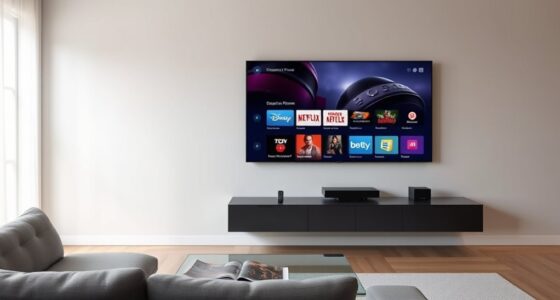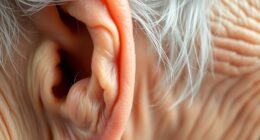Bone conduction transmits sound through skull bones directly to your cochlea, offering comfort, awareness of surroundings, and tactile feedback, but may have limited sound fidelity. Air conduction, on the other hand, channels sound through the air into your ear canal, delivering richer, more detailed audio ideal for immersive listening. Both methods have pros and cons, from noise leakage to environmental interference. To find the best fit for your needs, explore how each technology works and their practical uses.
Key Takeaways
- Bone conduction transmits sound via skull vibrations, offering comfort and situational awareness, while air conduction delivers richer, immersive audio through the ear canal.
- Bone conduction is ideal for outdoor use and extended wear, but has limited sound fidelity compared to the high-quality audio of air conduction.
- Air conduction provides clearer, more detailed sound, making it preferred for music, calls, and immersive listening experiences.
- Bone conduction allows users to stay aware of their surroundings, beneficial for safety during activities like running or cycling.
- Each method suits different needs: bone conduction for comfort and awareness, air conduction for superior sound quality.
How Bone Conduction and Air Conduction Work
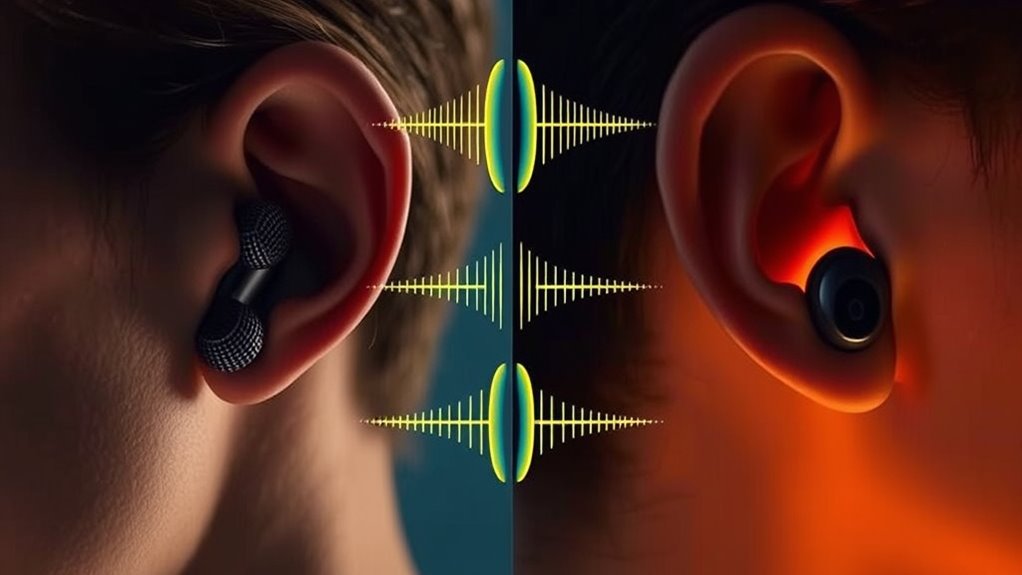
To understand how bone conduction and air conduction work, it’s important to recognize that they both transmit sound to your inner ear but through different pathways. In air conduction, sound waves travel through the air into your ear canal, vibrating your eardrum and ossicles, resulting in clear acoustic fidelity. Bone conduction bypasses the eardrum entirely by transmitting vibrations directly through the bones of your skull to your cochlea. This method often incorporates haptic feedback, providing tactile sensations that complement audio. While air conduction delivers high sound quality and detailed audio, bone conduction offers a unique experience that can enhance awareness of surroundings. Both methods serve different needs, but understanding their mechanisms helps you appreciate the technology behind each. Additionally, the choice between these methods can be influenced by factors such as sound quality and personal comfort preferences.
Advantages of Each Sound Transmission Method

Both bone conduction and air conduction offer unique benefits that make them suitable for different situations. Bone conduction provides clear sound quality without covering your ears, which enhances user comfort during extended wear and allows you to stay aware of your surroundings. It’s perfect for outdoor activities or situations where situational awareness matters. Air conduction, on the other hand, generally delivers richer sound quality, producing more detailed and immersive audio experiences. It’s ideal for controlled environments like listening at home or in quiet spaces, where comfort and sound clarity are paramount. Each method plays to its strengths: bone conduction for comfort and awareness, and air conduction for superior sound quality. Choosing the right depends on your needs and preferred listening environment. Incorporating protective styling benefits can also help maintain your hearing health when using these devices regularly.
Limitations and Challenges of Bone and Air Conduction
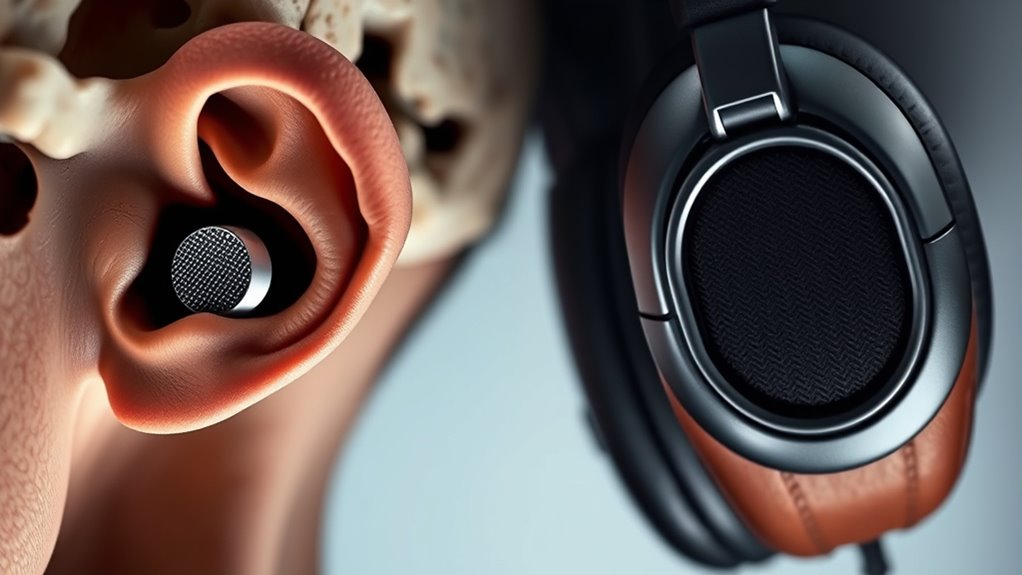
While bone conduction offers comfort and situational awareness, it faces challenges such as limited sound fidelity and potential sound leakage, which can reduce audio clarity and privacy. Material limitations play a role here; the transducers rely on specific materials that may not fully capture or transmit high-frequency sounds, affecting audio quality. Additionally, signal interference from environmental factors like electrical devices or physical obstructions can distort sound transmission. On the other hand, air conduction systems are susceptible to external noise, which can compromise listening experiences. Both methods also grapple with issues like background noise and sound distortion, but bone conduction’s unique challenge lies in balancing comfort with consistent audio performance despite material constraints and interference. These limitations highlight the need for ongoing innovation to improve overall functionality.
Practical Applications and Use Cases
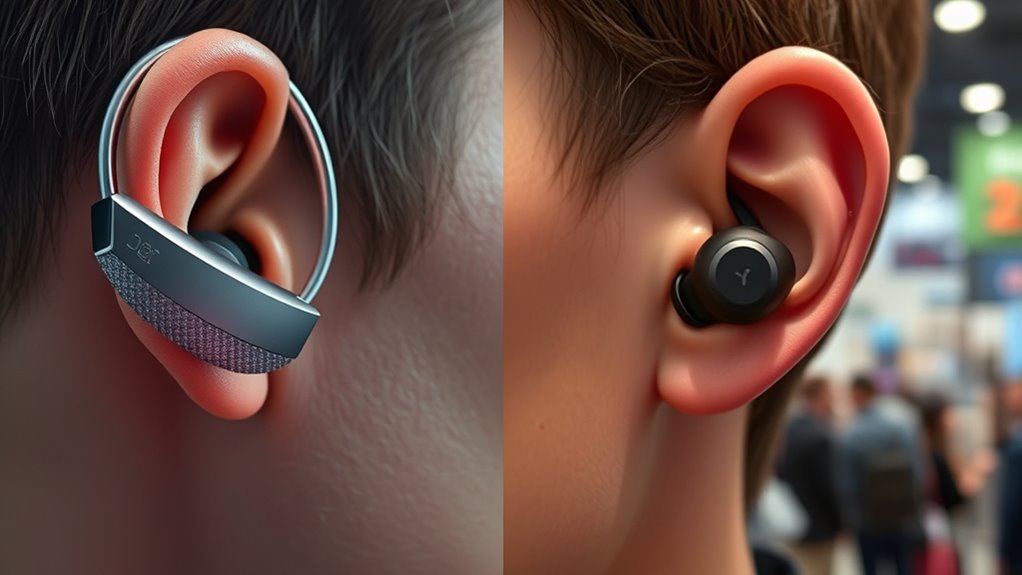
Bone and air conduction technologies have found diverse applications across fields like healthcare, communication, and entertainment. In healthcare, bone conduction devices help patients with hearing impairments by providing reliable, wireless compatibility that allows seamless use with smartphones and assistive tools. For communication, these technologies are popular in military and professional environments where durability factors matter—devices must withstand harsh conditions while maintaining sound clarity. In entertainment, bone conduction headsets are ideal for outdoor activities, offering durability and wireless convenience without blocking ambient sounds. Thanks to their robustness, these systems are increasingly used in sports and recreational settings. Additionally, their durability and safety features make them suitable for a wide range of practical applications, enhancing user experience across various demanding scenarios.
Choosing the Right Technology for Your Needs
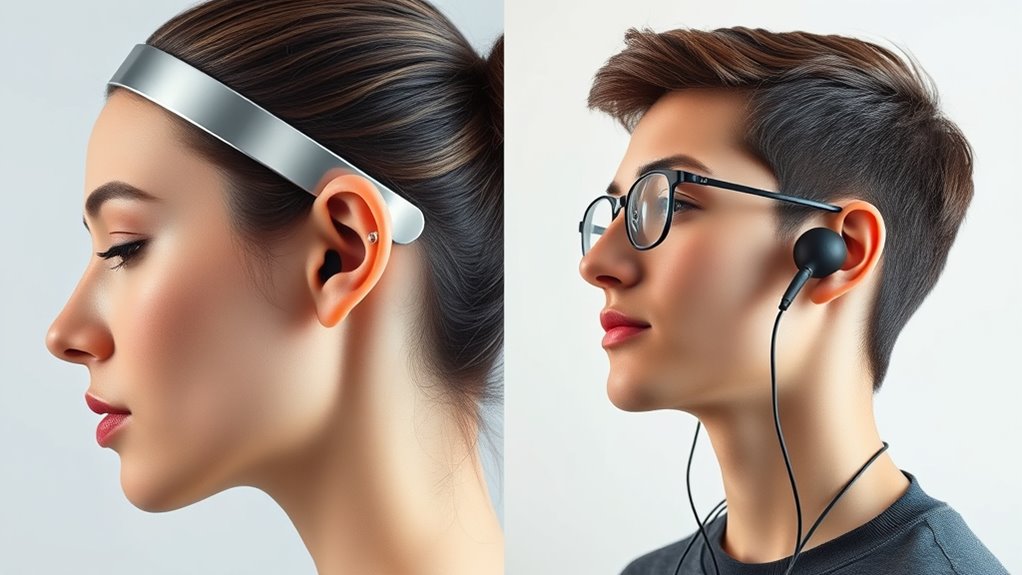
Choosing the right technology depends on your specific needs and environment. If you prioritize superior audio quality, air conduction devices often deliver clearer, more detailed sound. They’re ideal for situations where sound fidelity matters most, like listening to music or participating in calls. On the other hand, if user comfort and situational awareness are your priorities, bone conduction might be better. These devices sit outside your ear, reducing discomfort during extended use and allowing you to stay aware of your surroundings. Consider your activity—whether you need immersive sound or situational awareness—and your environment. Also, think about how each technology impacts your comfort during long periods of wear. Ultimately, choosing the right option balances your audio quality expectations with comfort for your daily use. Additionally, understanding the unique features of each technology can help you make a more informed decision tailored to your specific needs.
Frequently Asked Questions
How Do Bone Conduction Devices Impact Long-Term Hearing Health?
You might wonder how bone conduction devices affect your long-term hearing health. These devices promote hearing safety by bypassing the ear canal, reducing the risk of ear infections. Plus, their device durability ensures consistent performance over time. However, it is crucial to use them properly and follow guidelines to prevent potential strain on your bones or hearing system. Proper use helps you enjoy clear sound while safeguarding your hearing health long-term.
Are Bone Conduction Headphones Suitable for All Types of Hearing Loss?
You might wonder if bone conduction headphones suit all types of hearing loss. They’re generally a good option because of their hearing aid compatibility and ability to bypass damaged parts of your ear. However, they might not provide ideal noise cancellation or clarity for severe hearing loss. It’s best to consult an audiologist to determine if these devices meet your specific needs and offer the best hearing experience.
What Are the Latest Technological Innovations in Both Conduction Methods?
You’re curious about the latest innovations in conduction methods. Both bone and air conduction now feature advanced wireless connectivity, offering seamless streaming and reduced latency. Noise cancellation tech has improved in air conduction devices, enhancing listening in noisy environments. Meanwhile, bone conduction tech integrates miniaturized transducers for clearer sound. These innovations make both options more versatile, comfortable, and effective for various listening needs, pushing the boundaries of audio technology.
Can Bone Conduction Technology Be Integrated With Existing Hearing Aids?
You might wonder if bone conduction technology can be integrated with existing hearing aids. Compatibility challenges exist because of differences in design and how the devices transmit sound. However, advancements are making integration more feasible by focusing on seamless design integration and versatile components. If successfully combined, this could enhance hearing aid performance, providing clearer sound and comfort. With ongoing innovation, future hearing aids could incorporate bone conduction for improved user experience.
How Do Environmental Factors Affect the Performance of Each Conduction Type?
Imagine you’re trying to enjoy your favorite music, but background interference and ambient noise make it tough. Environmental factors vital impact conduction types; bone conduction often performs better in noisy settings because it bypasses external noise, while air conduction can struggle with ambient sounds. You might notice that in loud environments, bone conduction offers clearer audio, but in quiet spaces, both types work well. Your environment plays an essential role in your listening experience.
Conclusion
Choosing between bone and air conduction is like picking the right tool for a job—you need what fits your needs best. Bone conduction offers a discreet, active listening experience, while air conduction provides rich sound quality. Neither is perfect, but understanding their strengths and limitations helps you make an informed choice. Think of it as finding the right key to open your perfect hearing—each has its own unique tune, waiting for you to discover.







